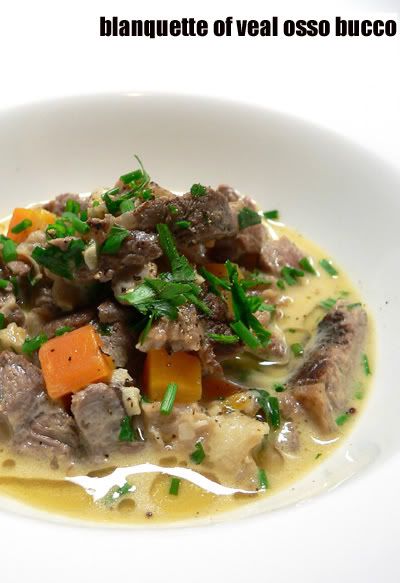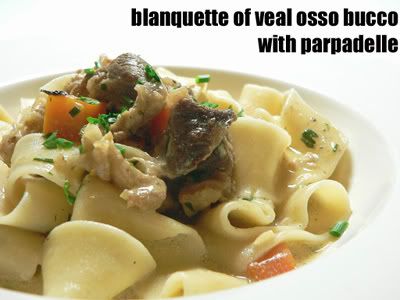
What is it about veal blanquette that appeals so much to me? Well, its probably the elegance and refinement derived from oh so common ingredients and simple techniques.
As with most other famous and celebrated French dishes, blanquette started off as a humble dish made of left-over ingredients from the day before. Technically, it is a stew of meat cooked in a white sauce. No prizes for guessing, considering that the word comes from the French term 'blanc' which means white. To look at it from another angle, Alan Davidson (Oxford Companion to Food) suggests that blanquette is the etymological cousin to 'blanket', in this sence referring to the rich white sauce blanketing the stew of meat and vegetables.
Blanquettes are commonly made with veal (today I use osso bucco), but can be just as easily made with pork or lamb. It is typically cooked with vegetables such as pearl onions, carrots, celery.. etc. However, a French purist would tell you that no matter what aromatic vegetables are used when cooking it, it is only the meat and the onions that are put on the plate eventually.
The meat is first cut to size and blanched in one round of water to remove all impurities and left-over blood traces. It is then placed back in the pot with aromatic vegetables and a bouguet garni, and simmered gently till tender. The meat and vegetables are then removed and the sauce thickened. Now here comes the interesting bit- A mixture of cream and egg yolks, known as a liasion, are whisked into the sauce over low heat, and act as a thickening agent while also giving the dish a creamy, velvety texture. The meat and vegetables are then added back in, and a good pinch of nutmeg lifts the flavour profile to another level. I live to serve it with a drizzle of porcini oil, which adds a touch more earthiness to the dish.
Many modern-day recipes call for roux in place of this liasion as a thickening agent, but me being me, I strongly believe in the latter. Roux also makes the sauce slightly starchy, which I find takes much away from the intentions of this wonderful, tradition-steeped dish.

Blanquettes are as versatile as any other stew. It can be served with rice, pasta or potatoes. You can do as I often do, mop up the lovely sauces with hunks of crusty bread. Today, I served the blanquette tossed with some fresh parpadelle, purchased from Jan Power's Farmers Markets in New Farm. If you are enthusiastic about food as I am, I sincerely hope you try cooking a blanquette too. Unfortunately, I'm not a big fan of writing recipes, because I personally never follow them. So I'm sorry if I can't provide you with a precise recipe at this time. But do know that there are tonnes floating around on the internet, and in good cook books. Enjoy!
Technorati tags: Food and Drink, Food, brisbane, food blogs, slow food, kitchen expeditions, Cooking, veal, blanquette, osso bucco, papardelle

1 comment:
this is a damn good blog. love it! good work guys!
Post a Comment